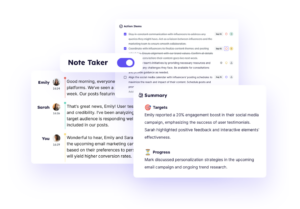In a recent study on webinars and their effectiveness, 73% of B2B marketers highlighted them as the most effective tool for generating quality leads. This statistic alone underscores the power of webinars for anyone aiming to connect with an audience and deliver impactful messages. So, what is a webinar, and why does it work so well? In this guide, we’ll break down everything you need to know about webinars, from their purpose to their undeniable advantages.
Webinar Definition
A webinar, short for “web seminar,” is an interactive online event that merges live presentations with digital engagement tools to create a dynamic learning environment. Unlike static videos or traditional online content, they use real-time interaction, enabling hosts to present slides, share screens, conduct Q&As, and foster a dialogue with their audience.
This digital format transcends geographical boundaries, allowing businesses, educators, and organizations to connect with global audiences without the logistical constraints of in-person events.
Webinars operate on Zoom, Microsoft Teams, and other platforms, which offer a variety of tools to improve the interactive experience:
Screen Sharing
Hosts can showcase their presentations, demonstrate software, or visually guide participants through content directly.
Interactive Polls and Surveys
These features allow hosts to gather feedback instantly, gauge audience sentiment, and keep participants engaged throughout the session.
Live Chat and Q&A
Real-time chat and Q&A sections enable participants to ask questions, engage with the content, and connect with both the host and fellow attendees.
Breakout Rooms
Tools like Zoom’s breakout rooms enable smaller group discussions, making the experience more interactive and collaborative.
Recording and On-Demand Access
Many webinar platforms allow sessions to be recorded, enabling participants to revisit the content later or catch up if they missed the live event.
These tools collectively create a rich and engaging environment, making webinars a preferred choice for delivering interactive and accessible content.
What is The Purpose of a Webinar?
Webinars serve various purposes, from marketing and education to community building and brand positioning. For businesses, webinars are a key strategy to generate high-quality leads, build authority, and foster trust with potential clients.
They are also powerful educational tools, allowing organizations to share insights, conduct training, or provide professional development opportunities remotely.
In the nonprofit sector, webinars help advocate for causes and engage with supporters on a more personal level. The interactive nature of them means that, unlike pre-recorded content, they offer audiences the chance to ask questions and interact directly with experts, making the learning experience more meaningful.
What is a Virtual Webinar?
A virtual webinar is an entirely online event, allowing participants to join from anywhere using webinar platforms. Virtual webinars are popular due to their accessibility—they are not limited by the constraints of physical venues, making them ideal for global audiences.
This format is particularly valuable for companies looking to connect with international clients, conduct remote training, or scale their outreach without incurring travel costs.
Webinar Formats
Webinars can be delivered in different formats, each providing distinct advantages. Choosing the right format depends on your audience’s preferences and the content you intend to share.
Live Webinars
Live webinars offer real-time interaction, making them one of the most engaging formats available. During a live webinar, the audience can ask questions, provide feedback, and participate in polls or surveys. This format is perfect for fostering immediate engagement and building a connection with participants. Live webinars require hosts to be prepared for spontaneous questions and adapt to the audience’s energy, making them ideal for Q&A sessions, interactive workshops, or live product launches.

Example: A SaaS company might host a live product launch, inviting customers to attend and ask questions as they unveil new features.
On-Demand Webinars
On-demand webinars are recorded sessions that attendees can access at any time, providing flexibility for those unable to join live. These cater to busy professionals who want the content but cannot commit to a specific time. On-demand webinars also allow hosts to extend the value of their content long after the live event has ended, providing continuous lead-generation opportunities. While these webinars lack real-time interaction, they are ideal for providing evergreen content that remains relevant over time.
Example: A marketing firm may offer an on-demand webinar on SEO strategies that users can watch whenever it’s convenient, ensuring the content stays accessible.
Hybrid Webinars
Hybrid webinars combine the best elements of live and on-demand formats, offering a blend of real-time engagement with pre-recorded segments. This format is useful when parts of the presentation need to be polished and professional while still offering a live component, such as Q&A or discussion. Hybrid webinars provide flexibility for hosts to pre-record complex demonstrations or interviews, reducing the pressure during the live portion. This also allows the host to focus on interaction while providing seamless transitions between live and recorded content.
Example: A tech conference may use a hybrid webinar format, where keynote speeches are pre-recorded but followed by live Q&A sessions to engage the audience.
Seminar vs Webinar: Understanding the Difference
While both seminars and webinars aim to educate and engage, they differ significantly in format and accessibility. Seminars are traditional, in-person events requiring attendees to be physically present, often limiting participation to those nearby.

Webinars, on the other hand, are conducted entirely online, allowing people from around the world to join without travel constraints. This shift to digital formats makes webinars more cost-effective and scalable, enabling hosts to reach larger, more diverse audiences. The interactive tools within webinars distinguish them by providing a level of engagement that seminars often can’t match.
Webinar vs Webcast: Do They Have Anything in Common?
While both webinars and webcasts are conducted online, their formats and objectives differentiate them. Webinars are designed to be highly interactive, encouraging participation through tools like Q&A sessions, polls, and live discussions. On the other hand, webcasts function as one-way broadcasts, delivering content to viewers with minimal interaction. Despite these differences, both formats use online platforms to reach wide audiences.
Webinars tend to work best for educational purposes and engagement-focused events, whereas webcasts are ideal for large-scale presentations, such as live-streaming keynote speeches or corporate announcements.
How Does a Webinar Work?
Webinars are powered by digital platforms that enable real-time connection between hosts and attendees from any location. The process begins with thorough planning, where the host outlines key topics, creates engaging content, and selects the right platform, such as Microsoft Teams or Zoom. Once the content is ready, invitations are sent to potential participants, often through email campaigns, social media, or dedicated landing pages. These efforts are aimed at attracting the right audience and boosting attendance.
During the live session, hosts typically share their screen to walk participants through presentations or demonstrate tools in action. However, what sets webinars apart is their interactivity—features like live chat, Q&A sections, and real-time polls allow the audience to participate actively. This back-and-forth engagement creates a dynamic atmosphere, turning a passive viewing experience into a two-way conversation.
After the event, hosts often use built-in analytics tools offered by platforms like GoToWebinar or Zoom to assess the webinar’s success. These tools provide valuable insights, such as how many participants stayed throughout the session, which parts of the presentation generated the most interaction, and where improvements can be made for future webinars. With these metrics, hosts can refine their content strategy, ensuring that each subsequent webinar delivers even more value to their audience.
What is a Webinar Funnel?
A webinar funnel, like a marketing funnel, is a carefully crafted process aimed at guiding participants from the moment they register all the way to taking meaningful action—whether that’s making a purchase, signing up for a service, or another desired outcome. It starts with targeted marketing efforts, such as social media ads and email campaigns, designed to attract the right audience and encourage them to sign up.
Once attendees are engaged, the webinar content is tailored to provide substantial value, addressing their pain points and offering solutions. After the session, post-webinar follow-up plays a crucial role. Through personalized emails, special offers, and surveys, you can continue nurturing these leads, eventually converting them into customers or clients. A well-designed webinar funnel ensures that each stage of the process is optimized, delivering value at every interaction and ultimately moving participants toward your goal.
Benefits of Setting Up a Webinar
Setting up a webinar offers numerous benefits, making it a valuable tool for businesses, educators, and organizations.
Cost-Effective Outreach
One of the major advantages of webinars is their cost-efficiency. Unlike traditional in-person events, which involve expenses like venue rentals, travel, and printed materials, webinars are hosted online, cutting down on these logistical costs. This makes them a budget-friendly option for organizations looking to reach a wide audience without the financial burden of hosting a physical event.
High-Quality Lead Generation
Webinars offer a direct and effective way to connect with potential customers. By presenting valuable content and engaging directly with attendees, you can build trust and credibility. This approach not only nurtures your audience but often results in high-quality leads. When done right, webinars help move prospects down the sales funnel, leading to conversions and long-term customer relationships.
Scalable Audience Reach
Unlike physical events, which have limitations in terms of venue capacity, webinars can accommodate as many attendees as needed. Whether you’re hosting a small, intimate session or a large-scale presentation, webinars allow you to scale effortlessly. This makes them perfect for organizations looking to extend their reach to a global audience without the constraints of physical logistics.
The Main Types of Webinars
Webinars come in various types, each tailored to specific goals and audience needs. Understanding the differences helps you choose the right format to effectively engage your audience and meet your objectives.
Educational Webinars
Educational webinars are designed with the primary goal of teaching and informing the audience. These sessions are often used by educators, trainers, and subject matter experts to dive deep into specific topics. The interactive nature of educational webinars, combined with visual aids such as slides or videos, enhances learning outcomes.
These webinars are ideal for online courses, professional development workshops, or training programs where attendees seek practical knowledge they can apply immediately. Attendees often leave these sessions equipped with new skills, insights, or certifications, depending on the focus.
Example: Universities or e-learning platforms frequently use educational webinars to deliver courses, supplement curriculums, or offer workshops that participants can attend remotely.
Product Demo Webinars
Product demo webinars showcase a product or service live, providing potential customers with an up-close look at how it works, its features, and its benefits. This format allows attendees to see the product in action, ask specific questions, and get real-time demonstrations. What makes product demo webinars so powerful is the immediate interaction—they are perfect for clarifying details, addressing customer pain points, and showcasing how the product can solve specific problems.
Example: Tech companies launching new software often conduct product demo webinars, walking users through the platform and highlighting key features in real time.
Thought Leadership Webinars
Thought leadership webinars position the host as an industry expert. These webinars dive deep into current trends, challenges, and future developments in a specific field. They often feature expert panels, interviews, or keynotes and aim to generate conversations on cutting-edge topics. By hosting thought leadership webinars, businesses and individuals can establish credibility, inspire their audience, and build trust, making them highly effective for brand positioning.
Example: An industry expert may host a thought leadership webinar discussing emerging trends in artificial intelligence, inviting other specialists to contribute their insights and foster meaningful discussions.
Setting up a Webinar With Krisp
One of the biggest challenges during a webinar is ensuring that no detail gets lost in the flow of conversation. Whether you’re hosting a complex technical demonstration or leading a panel discussion, keeping track of questions, key points, and participant input can be overwhelming. This is where Krisp’s real-time transcription comes in as a game-changer for webinar hosts.

Effortless Note-Taking and Transcriptions
Imagine being able to focus solely on delivering your content, knowing that every word is being transcribed in real time. Krisp’s Meeting Transcription feature captures every discussion point, question, and response, giving you an automatic record of the entire session without the need for manual note-taking. This means you can fully engage with your audience, knowing that no detail will slip through the cracks. No more scrambling to remember which points were most important or who asked which question—Krisp does the heavy lifting for you.
Instant Summaries for Seamless Follow-Up
Krisp doesn’t just stop at real-time transcription. After your webinar concludes, you’ll have access to a fully documented transcript that makes it easy to create detailed summaries.

These summaries can be shared with attendees, helping reinforce key takeaways or providing a reference for those who missed the live event. It’s a great way to keep your audience engaged and to ensure that the value of your webinar extends beyond the moment it ends.
Conclusion
From generating quality leads to fostering deeper audience engagement, webinars offer a versatile and powerful platform for reaching your goals. It’s important to understand what is a webinar and how to structure it because by doing so, you can unlock their full potential to connect with your audience in meaningful ways.
Whether you’re hosting a product demo, delivering a training session, or positioning yourself as a thought leader, webinars provide the tools and flexibility to make your message heard.
Frequently Asked Questions


